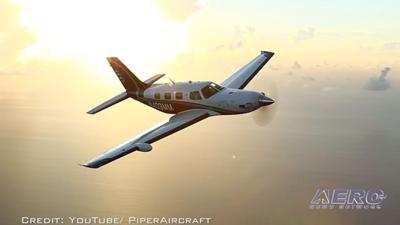Allows Full Utilization Of The Aircraft's Performance Envelope
AeroMech Incorporated has issued a Supplemental Type Certificate (STC) authorizing Reduced Vertical Separation Minimum (RVSM) certification for select Piper Meridian, M500, and M600 turboprop aircraft. The STC was approved by AeroMech’s FAA STC ODA.

Piper Meridian/M500/M600 aircraft with one of several approved avionics configurations are eligible to incorporate the RVSM STC without a change to the existing avionics configuration provided the aircraft geometry and systems are inspected and validated to the design RVSM specification. Once the STC is incorporated, Meridian operators will be able to utilize the full aircraft performance envelope and fly RVSM flight profiles to the aircraft’s maximum operating altitude. This allows Meridian pilots to gain fuel savings, lower their carbon footprint, increase range, and fly above bad weather. Operators investing in RVSM can expect higher resale values and shorter time on the market when it comes time to sell or trade.
Longtime RVSM proponent and Meridian owner/pilot, Arnold Sperling, M.D., said, “The additional RVSM flight levels will save fuel, extend range, and allow the pilot to find a comfortable cruising altitude over weather. The Meridian now can compete favorably in altitude with the TBM, fly 3,000 feet higher than the JetProp piston to PT6 conversion, and cruise at 280 knots using 260 PPH of fuel. AeroMech showed why they lead the industry in RVSM certifications with their meticulous flight-testing program and innovative approach to certifying the Meridian for RVSM when for years no one would undertake the program.”
The STC will consist of a set of instructions for initial and continued airworthiness (IICA) and an airplane flight manual supplement (AFMS) tailored to the avionics configuration (i.e. Meggitt/Avidyne/Garmin) in the candidate PA-46 airplane. The IICA will provide directions for maintenance professionals to initially validate that the airframe meets the Group requirements for RVSM compliance as well as maintain RVSM compliance over time with annual or biennial recurrent checks. The initial qualifying test consists of a pitot-static system accuracy and leak check, similar to the typical check now but with critical test points added, as well as an inspection of the static port/antenna installation critical area using a special 3-D scanning device. AeroMech will evaluate the test data and if satisfactory will confirm the aircraft meets the requirements for RVSM operation. AeroMech designed the RVSM error budget to maximize allowable variations in the qualification criteria and anticipates that the
majority of the fleet will pass initial inspection.
Operators interested in obtaining RVSM are encouraged to contact AeroMech’s wholly owned subsidiary, AMI Aviation Services (www.amiaviation.com), a part 145 repair station with locations at the Orlando/Sanford International Airport in Sanford, FL (KSFB) and in Smyrna, TN (KMQY) just outside of Nashville. AMI was a key player in the Meridian/M500/M600 RVSM flight-testing program, has the proper tools and training, and has immediate access to AeroMech engineering personnel. AMI will also discuss options with the operator to install avionics upgrades or a full RVSM-compliant avionics modernization, such as Garmin G500/G600 TXi, if desired. AeroMech may authorize additional qualified shops pending acquisition/instruction of the skin contour measurement scanner and associated training.
(Source: AeroMech news release. Image from file)
 ANN's Daily Aero-Term (05.09.24): Hold Procedure
ANN's Daily Aero-Term (05.09.24): Hold Procedure ANN's Daily Aero-Term (05.06.24): Altitude Readout
ANN's Daily Aero-Term (05.06.24): Altitude Readout ANN's Daily Aero-Linx (05.06.24)
ANN's Daily Aero-Linx (05.06.24) Airborne-NextGen 05.07.24: AI-Piloted F-16, AgEagle, 1st 2 WorldView Sats
Airborne-NextGen 05.07.24: AI-Piloted F-16, AgEagle, 1st 2 WorldView Sats Aero-News: Quote of the Day (05.07.24)
Aero-News: Quote of the Day (05.07.24)



